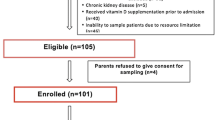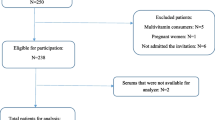Abstract
Objectives
To determine the vitamin D status and the association between vitamin D status and the clinical outcome of critically ill children admitted to pediatric intensive care unit (PICU) in South India.
Methods
Fifty-four consecutive children with medical and surgical diagnoses were included with parental consent. Severity of illness was assessed using PIM-2 score; Sequential Organ Failure Assessment Cardiovascular Score (CV-SOFA) was used to describe vasopressor use. Serum for 25(OH) D levels was obtained as close as possible to the ICU admission. Vitamin D deficiency was defined as serum 25(OH) D level < 20 ng/ml (50 nmol/L). Primary outcome measures were serum 25(OH) D level and in-hospital all cause mortality. Secondary outcomes were illness severity, vasopressor requirement, use of mechanical ventilation and duration of ICU stay.
Results
Of the 54 children, two were excluded due to insufficient serum for vitamin D analysis. Median age was 17.5 mo (IQR = 4.5–78); 38.5 % were infants. Higher age was associated with low vitamin D levels (r s = −0.34; p 0.01). Median serum 25(OH) D level was 25.1 ng/ml (IQR = 16.2–34.2). Shock (30.8 %), CNS conditions (23.1 %) and respiratory illnesses (21.2 %) were the three most common reasons for admission to the PICU. Vitamin D deficiency was seen in 40.3 % of the critically ill children. Higher PIM score or SOFA score were associated with low vitamin levels (r s = −0.29, p 0.04 and r s = −0.29, p 0.05 respectively). Children who were mechanically ventilated had a significantly lower median serum 25(OH) D level than those who were not on ventilation [19.5 ng/ml (IQR = 14.6–27.7)] vs. 32.1 ng/ml[(IQR = 16.5–50.9), p 0.01]. Serum 25(OH) D level was also positively associated with serum calcium levels (r s = 0.32, p 0.03). The proportion of children who died or were discharged terminally at parental request was 23.8 % among those with serum 25(OH) D level <20 ng/ml as compared to 16.1 % among those with serum 25(OH) D level >20 ng/ml (p 0.49).
Conclusions
Vitamin D deficiency is common among pediatric patients admitted to PICU in South India. Low serum 25(OH) D level was associated with higher severity of illness, need for mechanical ventilation, more vasopressor use and lower serum calcium levels. No association between vitamin D status and mortality was demonstrated.

Similar content being viewed by others
References
Rathi N, Rathi A. Vitamin D and child health in the 21st century. Indian Pediatr. 2011;48:619–25.
Holick MF. Vitamin D deficiency. N Engl J Med. 2007;357:266–81.
Lee P, Nair P, Eisman JA, Center JR. Vitamin D deficiency in the intensive care unit: an invisible accomplice to morbidity and mortality? Intensive Care Med. 2009;35:2028–32.
Lee P, Eisman JA, Center JR. Vitamin D deficiency in critically ill patients. N Engl J Med. 2009;360:1912–4.
Braun A, Chang D, Mahadevappa K, et al. Association of low serum 25-hydroxyvitamin D levels and mortality in the critically ill. Crit Care Med. 2011;39:671–7.
Higgins DM, Wischmeyer PE, Queensland KM, Sillau SH, Sufit AJ, Heyland DK. Relationship of vitamin D deficiency to clinical outcomes in critically ill patients. J Parenter Enteral Nutr. 2012;36:713–20.
Matthews LR, Ahmed Y, Wilson KL, Griggs DD, Danner OK. Worsening severity of vitamin D deficiency is associated with increased length of stay, surgical intensive care unit cost, and mortality rate in surgical intensive care unit patients. Am J Surg. 2012;204:37–43.
Arnson Y, Gringauz I, Itzhaky D, Amital H. Vitamin D deficiency is associated with poor outcomes and increased mortality in severely ill patients. QJM. 2012;105:633–9.
Rey C, S’anchez-Arango D, Lopez-Herce J, et al. Vitamin D deficiency at paediatric intensive care admission. J Pediatr. 2014;90:135–42.
Rippel C, South M, Butt WW, Shekerdemian LS. Vitamin D status in critically ill children. Intensive Care Med. 2012;38:2055–62.
McNally JD, Menon K, Chakraborty P, et al; On behalf of the Canadian Critical Care Trials Group. The association of vitamin D status with pediatric critical illness. Pediatrics. 2012;130:429–36.
Madden K, Feldman HA, Smith EM, et al. Vitamin D deficiency in critically ill children. Pediatrics. 2012;130:421–8.
Tiwari L, Puliyel JM. Vitamin D level in slum children of Delhi. Indian Pediatr. 2004;41:1076–7.
Marwaha RK, Tandon N, Reddy DR, et al. Vitamin D and bone mineral density status of healthy schoolchildren in northern India. Am J Clin Nutr. 2005;82:477–82.
Puri S, Marwaha RK, Agarwal N, et al. Vitamin D status of apparently healthy schoolgirls from two different socioeconomic strata in Delhi: relation to nutrition and lifestyle. Br J Nutr. 2008;99:876–82.
Joshi K, Bhatia V. Vitamin D deficiency in a tropical country-treatment and prevention in children. Indian J Pediatr. 2014;81:84–9.
Yadav M, Mittal K. Effect of vitamin D supplementation on moderate to severe bronchial asthma. Indian J Pediatr. 2014;81:650–4.
Agarwal DK, Agarwal KN. Physical growth of affluent Indian children. Indian Pediatr. 1994;31:377–413.
Agarwal DK, Agarwal KN, Upadhyay SK, Mittal R, Prakash R, Rai S. Physical and sexual growth pattern of affluent Indian children from 5 to 18 years of age. Indian Pediatr. 1992;29:1203–82.
Slater A, Shann F, Pearson G; Paediatric Index of Mortality (PIM) Study Group. PIM2: a revised version of the paediatric index of mortality. Intensive Care Med. 2003;29:278–85.
Vincent JL, de Mendonça A, Cantraine F, et al. Use of the SOFA score to assess the incidence of organ dysfunction/failure in intensive care units: results of a multicenter, prospective study. working group on “sepsis-related problems” of the european society of intensive care medicine. Crit Care Med. 1998;26:1793–800.
Holick MF, Binkley NC, Bischoff-Ferrari HA, et al. Evaluation, treatment and prevention of vitamin D deficiency: an endocrine society clinical practice guideline. J Clin Endocrinol Metab. 2011;96:1911–30.
Kempker JA, Tangpricha V, Ziegler TR, Martin GS. Vitamin D in sepsis: from basic science to clinical impact. Crit Care. 2012;16:316–21.
Contributions
KE: Designed the project, supervised patient care, was responsible for data collection & data management and drafted the manuscript; VJ: Performed the vitamin D assay; BA: Completed the statistical analysis; MN: Involved in patient care and assisted in data collection; AD and MS: Provided intellectual support for the conception of the study and critically reviewed the manuscript. KE will act as guarantor for this paper.
Conflict of Interest
None.
Source of Funding
Fluid Research Fund, Christian Medical College, Vellore.
Author information
Authors and Affiliations
Corresponding author
Rights and permissions
About this article
Cite this article
Ebenezer, K., Job, V., Antonisamy, B. et al. Serum Vitamin D Status and Outcome among Critically Ill Children Admitted to the Pediatric Intensive Care Unit in South India. Indian J Pediatr 83, 120–125 (2016). https://doi.org/10.1007/s12098-015-1833-0
Received:
Accepted:
Published:
Issue Date:
DOI: https://doi.org/10.1007/s12098-015-1833-0




